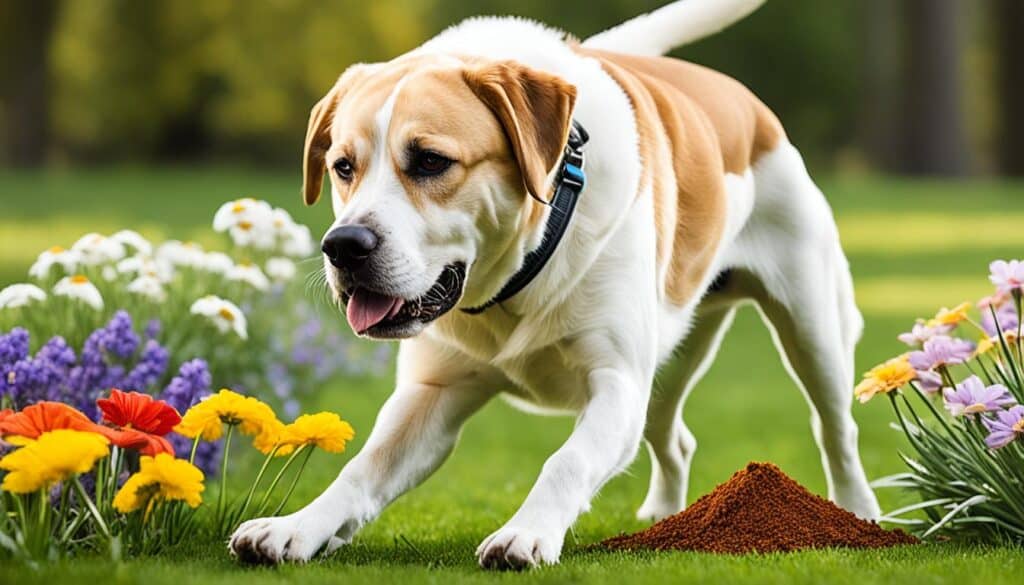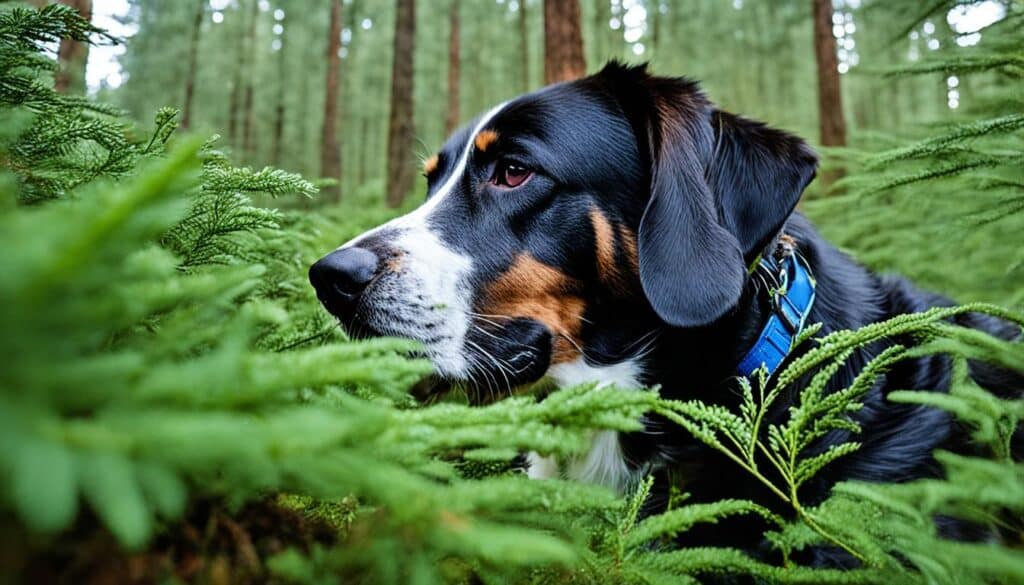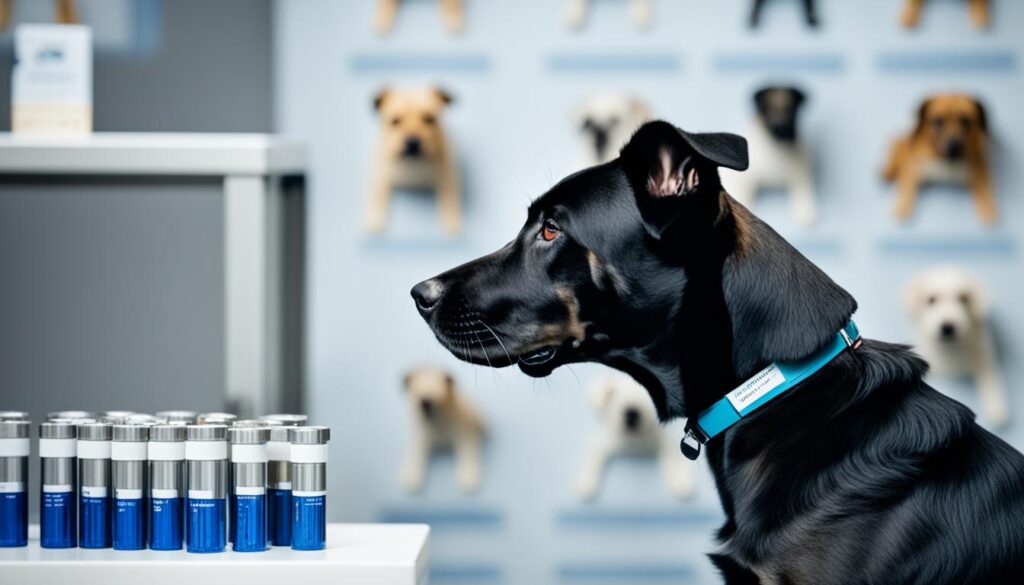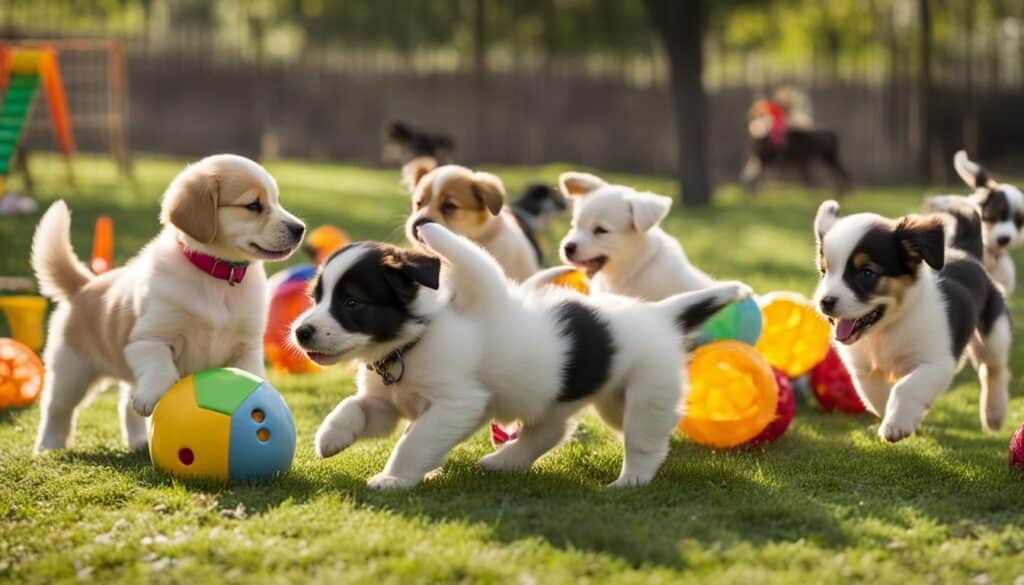Dog owners who want to improve their pet’s natural skills will love scent discrimination training. This training teaches dogs to recognize specific smells. It’s not just fun; it also sharpens their minds. Through scent work for dogs, they gain mental exercise. This strengthens the bond with their owners, too.

Key Takeaways
- Introducing your dog to scent discrimination training can lead to significant mental stimulation and a deeper human-animal connection.
- Practical training encourages dogs to use their nose, tapping into their exceptional sense of smell.
- Consistency and patience are crucial in accurately teaching your dog to identify specific scents.
- Engaging in scent work for dogs trains them and is an entertaining activity for both dog and owner.
- Scent discrimination training can have practical applications in work environments, competitive agility, and search activities.
Why Is Scent Discrimination Essential for Your Trailing Dog?
Scent discrimination is a crucial skill for trailing dogs. It’s more than recognizing smells; it’s about finding the right scent despite distractions. Understanding scent work profoundly benefits both the dog and their handler. It makes for a successful, well-rounded team.
Understanding the Basics of Scent Discrimination
Scent discrimination lets dogs identify a specific scent. This skill uses their instincts. It also challenges them to focus amidst various scents. This is crucial for their intellectual and instinctual growth.
The Role of Scent Work in a Trailing Dog’s Life
Scent work gives trailing dogs purpose and a communication method with their handlers. It’s more than just following a trail. It helps handlers know if a dog has found or lost a scent. This communication is vital in many tasks.
Benefits of Scent Discrimination Training for Dogs
Training dogs in scent discrimination offers many advantages. It improves their thinking skills and solves problems. This helps with behavior issues by using their energy wisely. Also, it strengthens the bond between the dog and the handler. And it gives dogs satisfaction from completing challenging tasks.
Advanced Techniques in Teaching Scent Discrimination
Exploring scent discrimination requires a lot of patience. It demands a careful approach to teach dogs these complex skills. It’s not only about introducing a scent to a dog. It’s also about sharpening its natural ability via advanced techniques in scent training. These methods significantly enhance a dog’s ability to tell scents apart.
Teaching Your Dog to Discriminate Between Different Odors
The journey to developing an expert sniffer starts with understanding scent differences. This means slowly introducing your dog to many scents. During training sessions, they learn to pick out specific ones in different places.
Using the Elimination Method to Enhance Scent Discrimination
One key strategy is the elimination method found in advanced techniques in scent training. You offer multiple scent choices, then remove the wrong picks. This helps dogs improve at pinpointing scents, which is crucial when they need to be very accurate.
Incorporating Different Environments in Scent Discrimination Training
For dogs to truly master scent work, they need to train in diverse settings. Varied environments present unique challenges. These challenges affect scent detection, pushing dogs to adjust their identification
| Technique | Application | Benefits |
| Discrimination Training | Introduce one scent at a time, then increase complexity with blends. | Enhances focus and differentiates specific target odors. |
| Elimination Method | Begin with several scents, excluding non-target scents as the dog learns. | Improves decision-making skills and scent recognition accuracy. |
| Varying Environments | Practice scent detection indoors, outdoors, and in crowded spaces. | Prepares dogs for real-world scenarios and variable distractions. |

Troubleshooting Common Scent Training Challenges
Scent work training brings several challenges that may impact a dog’s performance. Knowing how to solve these problems is vital for progress and the dogs’ well-being. Applying specific strategies can significantly improve the training’s outcome.
What to Do When Your Dog Fails to Discriminate Scents Accurately
Dogs sometimes need help to differentiate scents. Patience and minor adjustments help. Try simplifying the scents and training environment. They also build their skills step by step, ensuring they are ready for more complex tasks.
How to Keep Your Trailing Dog Motivated and Engaged
It’s essential to keep dogs excited about training. You can change the routines, introduce new scents, and reward their success. Watch their body language and energy to prevent burnout and keep them interested.
Adjusting Your Training Techniques for Sensitive Noses
Training dogs with sensitive noses requires special attention. Avoid overwhelming them with solid or varied odors. Start with light scents, then slowly add more intense ones. This careful adjustment prevents stress and makes learning enjoyable.
| Challenge | Strategy | Expected Outcome |
| Inaccurate Scent Discrimination | Simplify tasks; Increase positive reinforcement | Higher accuracy in scent detection |
| Lack of Motivation | Introduce variety and rewards | Engaged and eager participation |
| Sensitivity to Strong Odors | Begin with milder scents; Use gradual exposure | Adaptation without negative associations |
Being able to adapt is crucial in scent training. A trainer must observe and meet each dog’s unique needs. Tailoring your approach is about more than just better training. It also builds a stronger connection between you and your dog, leading to great results in scent work.

Essential Tools and Tips for Effective Scent Training
Training a dog’s nose is crucial. You need the right tools and advice for it. Selecting strong scents, creating a varied training kit, and training regularly are essential. These steps help improve a dog’s ability to smell.
Choosing the Most Potent Scents for Your Dog to Detect
Finding the right scents is essential for training. There are many to choose from. Pick ones that are strong and match what the dog will work with. This helps them do better in real situations.
Creating a Diverse Scent Training Kit
A varied training kit is essential. It should have many different smells and textures. This prepares dogs for various real-life tasks. Including many scents helps dogs learn to recognize different odors.
Expert Advice on Maintaining Consistency in Training
Being consistent is crucial to training success. Experts say to train often and repeat exercises. This helps dogs remember smells better. They learn faster and can identify scents more accurately.
In short, using solid scents, a varied kit, and consistent training is crucial. Following these steps will make any dog a scent expert. It’s all about practice and the right tools.
Conclusion
Scent discrimination training is a way to tap into dogs’ natural abilities. It enriches and shapes their skills through varied techniques. By emphasizing the value of this training, we see how it develops a dog’s sensory skills. Both dogs and handlers will see better results and bond more deeply through steady work.
The guide on scent training tactics provides a clear path to overcome challenges. It helps in enhancing your dog’s sense of smell. Whether starting or improving, these strategies are essential for success. They rely on using solid scents, changing environments, and solving problems efficiently.
The bond it builds with your dog is the accurate measure of scent training’s success. Using positive methods and understanding the process is crucial. This ensures your dog’s nose reaches its full potential. With the right approach and patience, any handler can achieve great things. This makes for rewarding experiences in both daily life and particular tasks.

